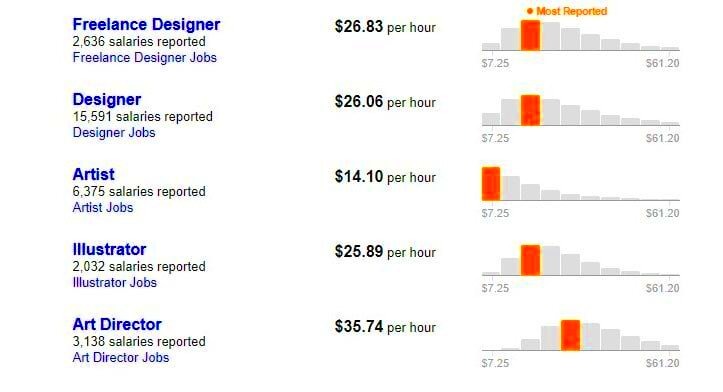Illustration as a profession has a wide spectrum of styles and areas. For freelance artists, it is vital to be aware of this environment for navigational success. Whether you focus more on illustrations for children’s books, digital art or branding, market knowledge is essential in setting your prices right.
Pricing work for illustrators may depend on various variables like market demands, trends among others whilst geographical positioning also plays a critical role. The flexibility of working for clients across diverse industries enhances an illustrators’ appeal. In order to develop their own niche style or pricing that matches them; designers should be aware of what is happening within the design field and what are the requirements of the clients.
Factors That Influence Illustration Pricing

As a solopreneur illustrator, there are numerous significant elements that may affect your pricing:
- Experience Level: Newer illustrators may charge less as they build their portfolio, while seasoned professionals often command higher fees.
- Project Complexity: More intricate or time-consuming projects typically warrant higher charges due to the skill and time required.
- Usage Rights: If a client wants to use your work commercially, you can charge more. The broader the usage, the higher the rate.
- Client Budget: Understanding your client’s budget can help you propose a rate that works for both parties.
- Market Demand: Rates can fluctuate based on the current demand for certain styles or types of illustrations.
When you take into account these elements, you can create a better pricing strategy that will be market-oriented.
Also Read This: How to Disable Your Fiverr Gig: A Step-by-Step Guide
Pricing Models for Freelance Illustrators
There are three pricing models typically employed by freelance illustrators:
| Pricing Model | Description | Pros | Cons |
|---|---|---|---|
| Hourly Rate | Charging clients for each hour of work. | Simple to calculate and ensures payment for all time spent. | Clients may be hesitant about open-ended projects. |
| Flat Rate | A fixed price for an entire project. | Clear cost for clients and can simplify the billing process. | Requires accurate estimation of time and effort upfront. |
| Per Illustration | Charging based on the number of illustrations. | Good for projects with a defined scope. | Can be challenging if illustrations vary greatly in complexity. |
Which model you prefer will depend on your style, the project’s character and what clients want. To avoid misunderstandings it is important to have clear conversations with customers about your pricing designs.
Also Read This: Can You Use Fiverr to Promote a Click Funnel?
Setting Your Rates Based on Experience
As a freelance illustrator, the sum of your skills and knowledge greatly impacts on the amount you should charge. To attract clients, beginners may start with reduced rates; however, those who have been in this business for some time could demand higher payments. Knowing where you land within this continuum allows one to come up with reasonable and market-based prices.
This is how experience generally impacts fees:
- Entry-Level Illustrators: If you are just starting, consider charging between $20 to $50 per hour or $100 to $300 for smaller projects. This helps build your portfolio and gain valuable experience.
- Intermediate Illustrators: With a few years of experience and a solid portfolio, you can increase your rates to $50 to $100 per hour or $300 to $800 per project, depending on complexity.
- Experienced Illustrators: Those with extensive portfolios and a strong reputation can charge $100+ per hour or $800 to $3000 per project. Your established client base will also help in justifying these rates.
It’s important to keep in mind that as you become more experienced and develop your unique style, you need to go back and review your rates from time to time so they match with what you have achieved.
Also Read This: How to Sell on Fiverr Fast
How to Research Competitor Pricing
Dipping your toes into various charges by diverse freelance illustrators will help you set yours accordingly. The following are steps to take:
- Explore Online Platforms: Websites like Fiverr, Upwork, and Behance can give you a glimpse of what illustrators are charging based on their skill level and experience.
- Network with Peers: Connecting with fellow illustrators through social media or professional groups can provide firsthand insights into their pricing strategies.
- Review Portfolios: Analyze the work and rates of illustrators whose style resonates with yours. Look at their experience and the complexity of their projects to gauge reasonable pricing.
- Check Client Reviews: Read client feedback to understand how clients perceive value. Positive reviews can justify higher rates.
When everything is said and done, try finding that sweet and lovely spot where you charge less money than your competitors while still making sure you're providing them something others don't offer. That way people will know about you in good terms.
Also Read This: What is Fiverr Commercial Use?
Communicating Your Value to Clients
After determining your fees, it is important to show potential clients why they should choose you for the job. Ways of doing this include:
- Highlight Your Portfolio: Showcase your best work that aligns with the client's needs. A well-curated portfolio speaks volumes about your skills and style.
- Explain Your Process: Walk clients through how you work. Discuss your creative process and how you approach projects, helping them understand the value behind your rates.
- Share Testimonials: Positive feedback from previous clients can greatly enhance your credibility. Use testimonials to highlight successful projects and satisfied clients.
- Discuss Benefits: Explain how your illustrations can help clients achieve their goals. Whether it’s enhancing their brand or engaging their audience, clearly articulate the benefits.
- Be Open to Questions: Encourage clients to ask questions about your rates and services. This openness can build trust and demonstrate your willingness to collaborate.
You can charge your charges and build strong connections with clients throughout life by properly expressing what you offer.
Also Read This: How to Rank Your Fiverr Gig in 2021
Adjusting Your Rates Over Time
Rates have to be reassessed from time to time as a freelance illustrator. Creative sector always changes; hence, prices of last year may no longer match your competencies or even demands in terms of employment. For freelancers, changing fees could be an awkward issue but an important one that ensures continued success.
Consider these factors listed below that could help to adjust your rates:
- Increased Experience: With more projects under your belt, you’ve likely improved your skills. If you’ve gained expertise, it’s time to reflect that in your pricing.
- Expanded Portfolio: If you’ve added impressive work to your portfolio, use that as leverage to raise your rates. Clients often pay more for quality and variety.
- Market Trends: Stay updated on industry trends. If similar illustrators are raising their prices due to increased demand, it might be time for you to do the same.
- Client Feedback: Listen to what your clients are saying. If they frequently express satisfaction with your work, they might be willing to pay more.
- Inflation and Living Costs: Consider the economic landscape. If costs of living are rising, it’s reasonable to adjust your rates accordingly.
In case you want to increase your charges, be frank with your clients on why that’s what you’re thinking. This way there will always be trust and comprehension.
Also Read This: How to Get Fiverr Refund for Canceled Orders
Frequently Asked Questions
A common question asked by freelance illustrators as pertains to pricing and rates includes:
- How do I know if my rates are competitive? Research other illustrators in your niche, consider your experience, and assess the quality of your work compared to theirs.
- What should I do if a client says my rates are too high? Listen to their concerns and consider negotiating or providing different pricing options based on their budget.
- Is it okay to charge different rates for different clients? Yes, it’s common to adjust rates based on factors like client budget, project scope, and long-term relationships.
- How often should I adjust my rates? It’s a good practice to review your rates annually or whenever you’ve significantly improved your skills or completed high-value projects.
Answering these questions can illuminate the pricing mechanism and thereby assist illustrators in determining their value.
Conclusion
Setting and adjusting your rates as a freelance illustrator is a significant portion of your business. You will be able to create an enduring and fruitful career by understanding the market forces at play, taking cognizance of price determinants, and articulating your worth in a way that makes sense to clients. Remember, pricing is not merely numerical; it is about understanding one’s own abilities as well as demonstrating worth in the eyes of potential customers.
Be in touch with the latest going-on at all times, have confidence in yourself as an individual who is worth knowing and don’t be afraid to make changes when they are needed along the way. Career paths are like journeys; every little thing that you do to find out your worth leads to more triumphs and fulfilling moments in private art work.




